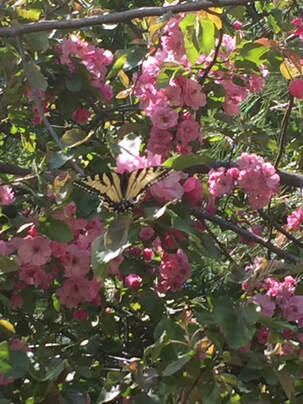 In Abiquiu, late one March morning, one glorious yellow swallowtail visited my narcissus, grape hyacinths and my glowing cactus garden. I watched this one butterfly with deep pleasure mixed with concern remembering years of Tiger Swallowtail abundance. These beautiful insects used to arrive in such numbers…. Swallowtails have always been one of my favorite butterflies and over the period of a lifetime I have raised many eggs to the adult stage. Two mornings ago while walking up a woods road here in Maine I was delighted to see 10 swallowtails “puddling” (the most I have seen in years). Puddling occurs when the swallowtails gather together to drink from small oases that are filled with salt deposits, and I have only witnessed this phenomenon in the spring. With the catastrophic decline of all insects, seeing these delicate creatures become more of a gift than ever before. I cannot tell the difference between eastern and western swallowtails but both are found in wooded or riparian areas. The 'tails' and bright blue and red eyespots, that most of the butterflies within this family are adorned with, are a form of 'back to front mimicry' that helps to confuse visual predators. Birds will strike at these eyespots, and often get nothing more than a fragment of wing, leaving the vital parts of the butterfly unscathed. There are a number of other characteristic traits shared by members of this family. Eggs are dome shaped or smooth and globular, and usually laid singly on the host plant. In the Southwest, cottonwoods, willow, fruit trees and chokecherry are host plants; in the north, poplar, black cherry, hemlock, fruit trees, chokecherry and alders are favorite egg laying spots. In the garden growing anise, parsley, dill, or sweet fennel attracts this butterfly. I noticed the swallowtails loved the wild purple mustard flowers in Abiquiu. Here in Maine I see them on the flowering crabapples and Queen Annes lace (wild carrot). The larvae are smooth skinned, and greenish and eggs are laid underneath the leaves. Early instar larvae often mimic a bird dropping. All possess an organ called an osmeterium that discharges a foul scent that discourages visual predators. Another form of protection that all swallowtail larvae use is to simply drop off a plant on a silk cord that these wily insects manufacture themselves to escape predators. It is estimated that perhaps one in hundreds of eggs laid by each female actually makes it through the four stages to adulthood. Once hatched the larvae grow rapidly; eating, defecating, and resting in between each molt. The later instar larvae have large inflatable eyespots towards the front end of the body, which supposedly mimic a snake's head, and presumably warn off visual predators. These are gorgeous creatures. In about three weeks the caterpillars are ready to pupate and spin a chrysalis around themselves. They will remain in the pre-pupa stage for about a day before becoming swallowtails who rest while drying their wings unless diapause occurs. Diapause is believed to be a 'risk-spreading' strategy in an environment that may or may not provide enough host plant material for another generation right away. Individuals are mature and ready to breed when optimal conditions exist. If you ever find swallowtail eggs (the internet has excellent images for the curious) try to raise them. It is impossible to relate how exciting it is to watch this entire process unfold and I recommend it to anyone as one of Nature’s routine miracles.
0 Comments
Your comment will be posted after it is approved.
Leave a Reply. |
Submit your ideas for local feature articles
Profiles Gardening Recipes Observations Birding Essays Hiking AuthorsYou! Archives
October 2025
Categories
All
|
 RSS Feed
RSS Feed